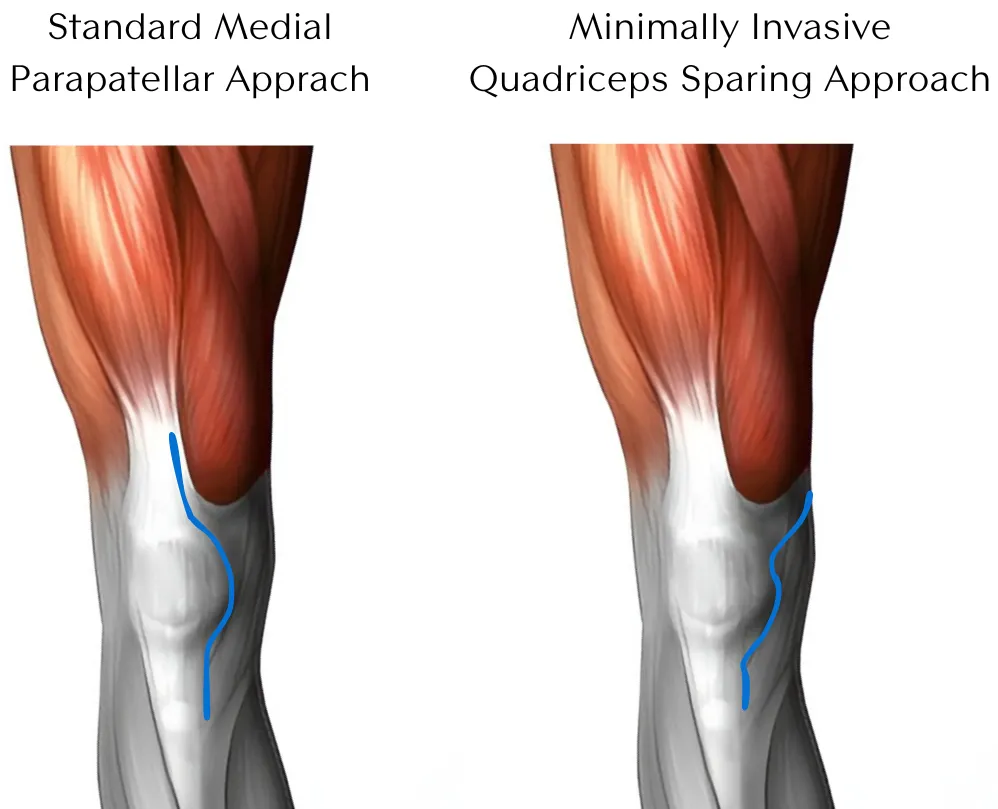Quadriceps Sparing Knee Replacement
About Knee Replacement
Quadriceps Sparing Knee Replacement is a minimally invasive surgical technique for total knee replacement (TKR) that avoids cutting through the quadriceps tendon, the large muscle group in the front of the thigh.
Quadriceps Sparing Knee Replacement represents a significant advancement in orthopedic surgery. It offers reduced pain, quicker recovery, and improved long-term outcomes for suitable candidates. However, its success largely depends on the surgeon’s expertise and patient selection.
This innovative approach reduces tissue damage, accelerates recovery, and minimises pain compared to traditional knee replacement surgery.
Below is a detailed explanation of the procedure's advantages, candidates, risks, and recovery process.
What is Quadriceps Sparing Knee Replacement?
Traditional total knee replacement involves cutting through the quadriceps tendon to access the knee joint. The quadriceps sparing technique, by contrast, uses a smaller incision and navigates around the quadriceps muscle and tendon. This preserves the integrity of the muscle, which plays a critical role in knee stability and mobility.
By avoiding trauma to the quadriceps, this procedure allows for faster post-operative recovery and less discomfort for patients.
Advantages of Quadriceps Sparing Knee Replacement
The approach enables faster recovery and better Patellar tracking during movements resulting in:
- Reduced Pain - Avoiding the quadriceps tendon reduces post-surgical pain significantly.
- Smaller Incision - The incision is typically about 11 cm, compared to about 20 cm in traditional surgery, leading to better cosmetic results.
- Faster Recovery - Patients often regain mobility sooner due to minimal disruption of muscle tissue.
- Improved Muscle Function -Preserving the quadriceps tendon enhances knee strength and stability after surgery.
- Shorter Hospital Stay - Many patients are discharged within 24-48 hours post-surgery.
- Lower Risk of Complications - Reducing soft tissue damage minimizes the risk of complications like infection or excessive bleeding.

Who is a Candidate for Quadriceps Sparing Knee Replacement?
This technique is not suitable for all patients. Ideal candidates typically include:
- Early-Stage Osteoarthritis Patients - Individuals with less complex knee joint deformities.
- Active Individuals - People who want to return to an active lifestyle quickly.
- Patients Without Significant Obesity - Excess weight may limit the visibility and accessibility of the surgical field.
- No Severe Deformities - Patients with severe knee joint deformities may require a more traditional approach.
A thorough preoperative evaluation is necessary to determine the suitability of this technique.
The Procedure: What to Expect
- Preparation - Preoperative imaging, such as X-rays or MRIs, helps the surgeon plan the procedure.
- Anesthesia - Regional (spinal) or general anesthesia is administered.
- Surgical Technique:
- The surgeon makes a small incision on the front of the knee.
- Specialised instruments allow access to the joint without cutting through the quadriceps tendon.
- The damaged joint surfaces are removed and replaced with a prosthetic implant.
- Closure - The incision is closed with sutures or staples, and a sterile dressing is applied.
Recovery and Rehabilitation
- Hospital Stay - Most patients can stand and walk with assistance on the same day of surgery.
- Pain Management - Pain is typically managed with oral medications, and patients report lower pain levels compared to traditional surgery.
- Physical Therapy - Rehabilitation starts immediately, focusing on restoring mobility and strength.
- Return to Normal Activities - Many patients return to normal activities, including driving, within 4-6 weeks.
- Long-Term Outcomes - Patients often experience improved knee function and reduced pain in the long term.
Risks and Complications
Although the quadriceps-sparing approach reduces certain risks, it is not entirely free of potential complications. These include:
- Infection - As with any surgery, there is a small risk of infection.
- Blood Clots - Anticoagulant therapy and compression stockings mitigate this risk.
- Implant Issues - Rarely, the prosthetic components may loosen or wear out over time.
- Limited Visibility -The smaller incision can make the procedure technically challenging for surgeons, potentially impacting outcomes if not performed by an experienced specialist.
Alternatives to Quadriceps Sparing Knee Replacement
Patients who are not candidates for this technique might consider:
- Traditional Total Knee Replacement - Effective for severe deformities or advanced arthritis.
- Partial Knee Replacement - Suitable for localised joint damage.
- Robotic-Assisted Knee Replacement - Enhances precision in implant placement.
Cost of Quadriceps Sparing Knee Replacement in Australia
The cost of knee replacement surgery varies depending on factors like hospital fees, surgeon’s fees, and insurance coverage. The out-of-pocket expense ranges between AUD 8,000 to AUD 15,000 for insured patients. Public healthcare options may cover the procedure at reduced costs, albeit with longer wait times.
| Feature | Quadriceps Sparing Approach | Traditional Approach |
|---|---|---|
| Incision Size | Smaller (10-12 cm) | Larger (15-20 cm) |
| Muscle Disruption | Minimal | Significant |
| Recovery Time | Faster (4-6 weeks) | Longer (6-12 weeks) |
| Pain | Less post-operative pain | More pain |
| Hospital Stay | Shorter | Longer |
| Suitability | Select cases | Suitable for complex cases |


